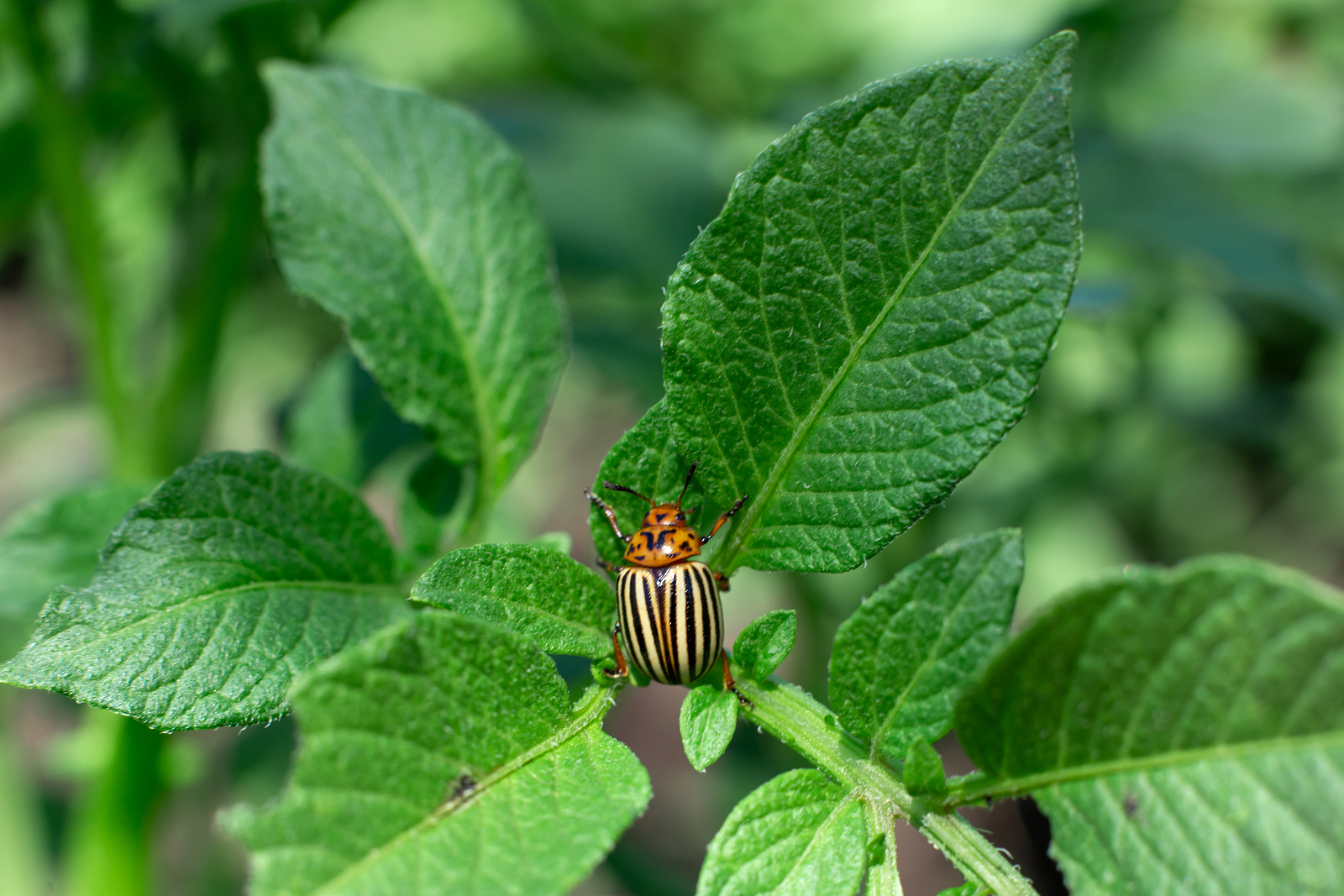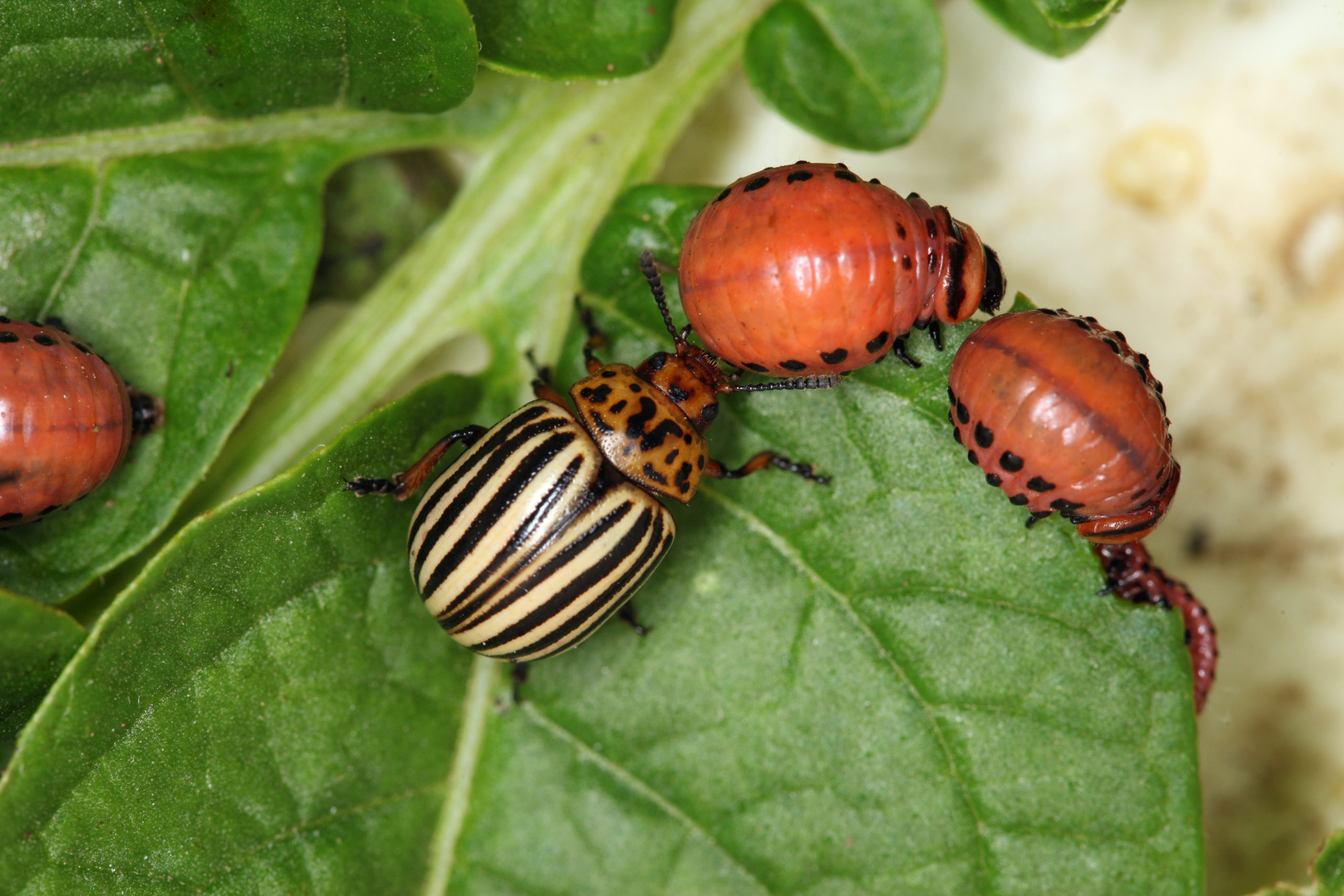The Colorado potato beetle attacks potatoes, eggplants, peppers, and tomatoes skeletonizing leaves and defoliating plants.
Horticultural cloth draped over plants will exclude beetles from reaching plants to lay eggs and feed, diatomaceous earth will destroy larvae, and the botanical poisons pyrethrum and rotenone can kill heavy infestations of adult beetles. However, where Colorado potato beetles are well established complete control may be nearly impossible; one female can lay 10,000 eggs in a season.
The Colorado potato beetle (Leptinotarsa decemlineata) is yellow with black stripes on its wing covers and has dark spots just behind its head. The beetle grows to ⅓ inch long. The females lay orange eggs in rows on the underside of leaves. The larvae are humpbacked and plump, red with black legs and black spots on each side.
Colorado potato beetles have a life cycle of one to three generations per year, but many adults can live for two full years, overwintering in the soil. They can first be spotted in spring as soon as potatoes sprout in the garden. They will stay on in the garden through flowering and harvest unless controlled. Both adults and larvae feed on leaves; the larvae are the most voracious eaters.
Colorado potato beetle lifecycle
Adult Colorado potato beetles are oval with hard convex yellowish-white wing covers marked with lengthwise black stripes. Adults are about ⅓ inch long. Larvae are humpbacked grubs reddish to salmon-colored with blackheads and two rows of black spots along both sides of the body.
Adults and grubs chew on the leaves of potato-family plants—potatoes, eggplants, tomatoes, and peppers. A heavy infestation can defoliate a plant.
Good Products for Pest and Disease Control at Amazon:
- Garden Safe Snail and Slug Bait
- Bonide Sulfur Fungicide
- Monterey BT Caterpillar Killer
- Neem Bliss 100-% Cold Pressed Neem Oil
- Safer Brand Insect Killing Soap
- PyGanic Botanical Insecticide
Potato beetles emerge from the soil in spring at about the same time that potato shoots emerge. The beetles walk to host plants and then climb up the stalks to feed. Adults mate and females lay rows of bright orange eggs on the undersides of leaves.

Humpbacked grubs hatch from eggs after 5 to 15 days, depending on how warm the weather is. They feed in groups at first then spread out to cover an entire plant. Larvae progress through four distinct growth stages (instars) over a 10-day period. About 13 days after hatching the prepupae drop to the soil and burrow to a depth of several inches, then pupate. The adults emerge in a few weeks to continue the life cycle, or, if the weather is chilly, delay emergence until spring.
There are one to three generations per year.
Potato beetles can be found throughout North America and Canada, except in the South.
Scientific Name: Leptinotarsa decemlinata
Target plants
Eggplants, peppers, potatoes, and tomatoes (these are members of the nightshade family, also called the tomato family or potato family).
Feeding habits and damage
Adults and grubs feed on leaves; a heavy infestation can defoliate a plant.
Organic controls
There are several defenses against Colorado potato beetles. Mulch well with a 1-foot layer of clean hay or straw. Handpick eggs and crush them (eggs resemble ladybug eggs but are larger and more orange). Handpick larvae and drop them in soapy water. Apply rotenone, spinosad, or neem as a last resort if the infestation is bad (these natural insecticides will also kill beneficial insects so apply in the evening when beneficial insects are less active).
Timed planting
Plant potatoes about one month earlier or later than you otherwise might that way the plants are either mature or have not yet emerged at the time the beetles emerge in spring. Potatoes generally are planted in spring when the soil temperature reaches 50°F.
Straw mulch
A thick layer of straw mulch—at least 4 inches—can make it difficult for beetles to find seedlings or plants.
Row covers
Beetles can be excluded when crops are protected by row covers at planting time. Seal the edges to make sure beetles cannot get in or are not trapped inside the cover.
Handpicking
Beetles and larvae can be handpicked off leaves and destroyed in a can of soapy water. Check crop leaves twice a week for eggs, larvae, or adults. Be sure not to pick off lady beetles or their eggs by mistake; lady beetles are beneficial to crops.
Diatomaceous earth
Spread diatomaceous earth around plant stems and even on leaves. This fine powdery material made from prehistoric sea shells will cut up soft-bodied larvae when they crawl across it.
Biocontrols
Apply Bt (Bacillus thuringiensis) to kill small larvae. Large larvae and adults can be killed with rotenone and pyrethrum, strong, but short-lived botanical poisons. Spray these on crops at dusk when bees are least active; the toxins will break down in about six hours.
Neem
Neem oil extract is a larvae toxin and repellent. It can be sprayed on plants every four days until the concentration of pests subsides.

Colorado potato beetle organic control calendar
Here is what you can do seasonally to control Colorado potato beetles:
- Before planting: Plant an early maturing potato variety. Pull out nightshade-family weeds in spring before beetles emerge; these weeds can serve as food sources and egg-laying sites. Rotate tomato family crops from one place to another in your garden each year; this will make it harder for beetles to find the crop. Plant nectar crops to attract beneficial insects such as spindled soldier bugs; soldier bugs feed on potato beetles.
- At planting time: Plant early maturing varieties of potatoes about one month earlier or later than usual; early potato crops will be near harvest by the time beetles emerge and begin to feed. Put 4 inches of straw around crops; beetles find it difficult to traverse straw. Cover plants with a row cover at planting time and seal the edges to exclude emerging beetles. Begin looking for beetles on plants as soon as potatoes sprout in the garden. Check leaf undersides for clusters of bright orange eggs. Look for humpbacked grubs and dark spots of excrement on foliage.
- While crops develop: Colorado potato beetles emerge from the soil at about the same time that potato shoots emerge in spring. The beetles walk in search of host plants and then climb up the stalks to feed. Collect and destroy eggs, larvae, and beetles. Be sure you don’t destroy ladybugs or their eggs by mistake. Remove beetles from plants with a handheld vacuum cleaner. Use spinosad, Beauveria bassiana, or Bt to kill larvae. As a last resort, spray pests with spinosad or neem.
- After harvest: Remove all spent nightshade-family crops, weeds, and debris from the garden after harvest. Plan to plant tomato-family crops in a different bed next year to slow the progress of beetles.
Natural predators
Insect predators include beneficial nematodes that burrow inside beetles to reproduce; they release bacteria that kill beetles. Chalcid, Trichogramma, and Colombian wasps parasitize the eggs of beetles. Assassin bugs, ground beetles, ladybugs, soldier bugs, and stinkbugs are predators. Animal predators include many birds including Baltimore orioles, bluebirds, cardinals, chickadees, grosbeaks, juncos, purple finches, and robins,
Potato articles at Harvest to Table:
How to Plant and Grow Potatoes
6 Easy Steps to Grow Organic Potatoes
Grow Potatoes in Pots and Grow Bags: Seven Easy Steps
Seven Ways to Cook and Serve Potatoes
How to Cook New Potatoes with No Recipe
How to Make Seasonal and Flavorful Potato Salad
Yellow Potato Side Dish and Soup
Ham, Potato, and Cheese Gratin
Potato Growing Problems Troubleshooting
Colorado Potato Beetle Organic Pest Control
Related articles:
Vegetable Garden Organic Pest Control
Vegetable Garden Diseases Problem Solver
Vegetable Garden Organic Weed Control
Garden Planning Books at Amazon:
- Vegetable Garden Almanac & Planner
- Kitchen Garden Grower’s Guide Vegetable Encyclopedia
- Vegetable Garden Grower’s Guide
- Tomato Grower’s Answer Book















